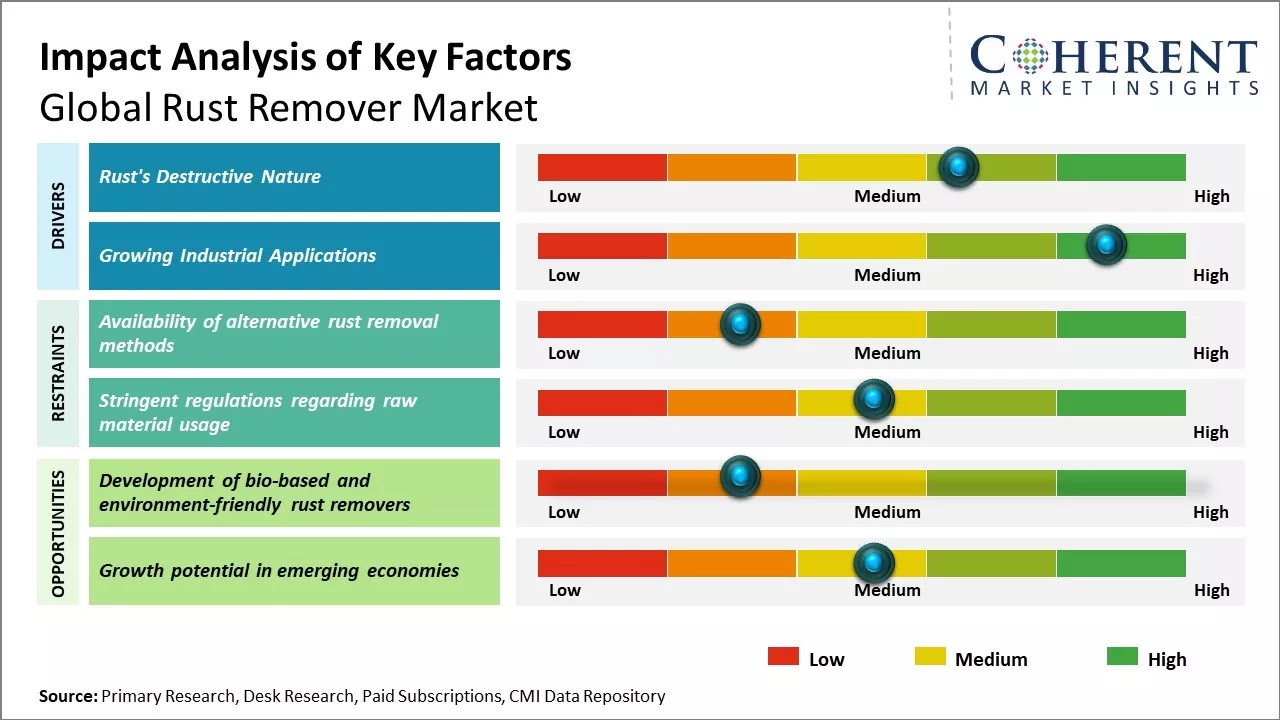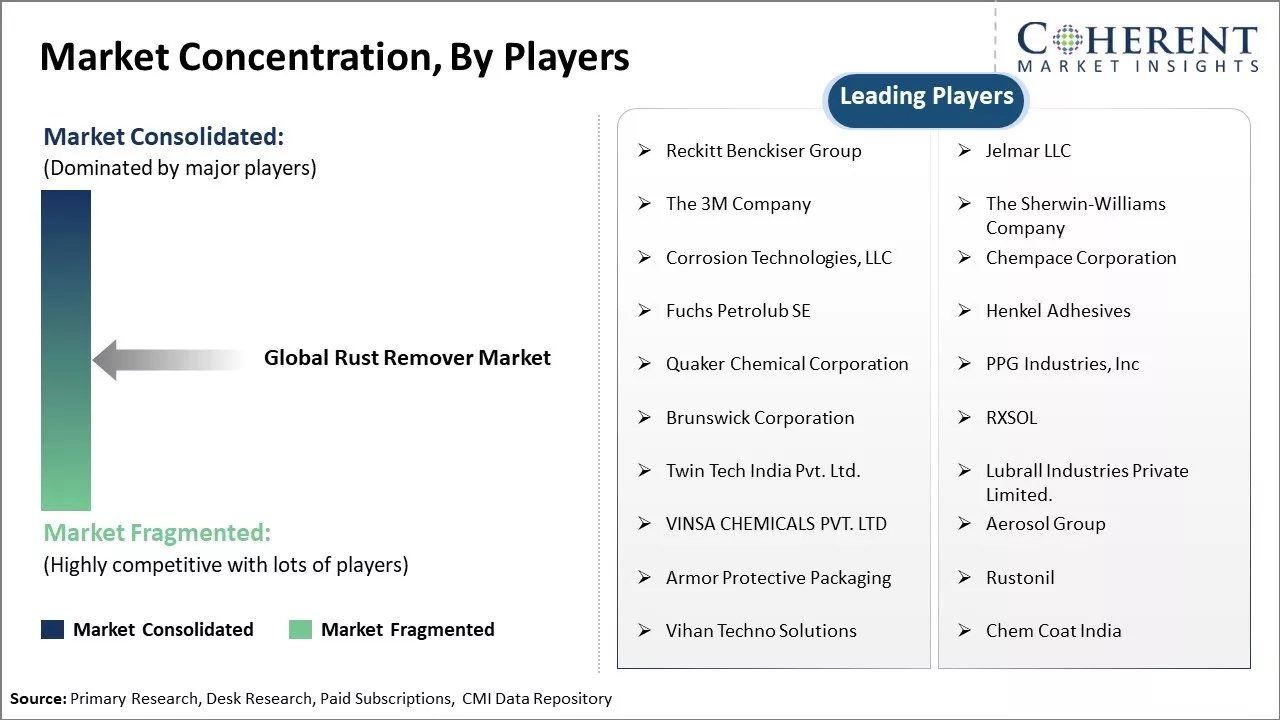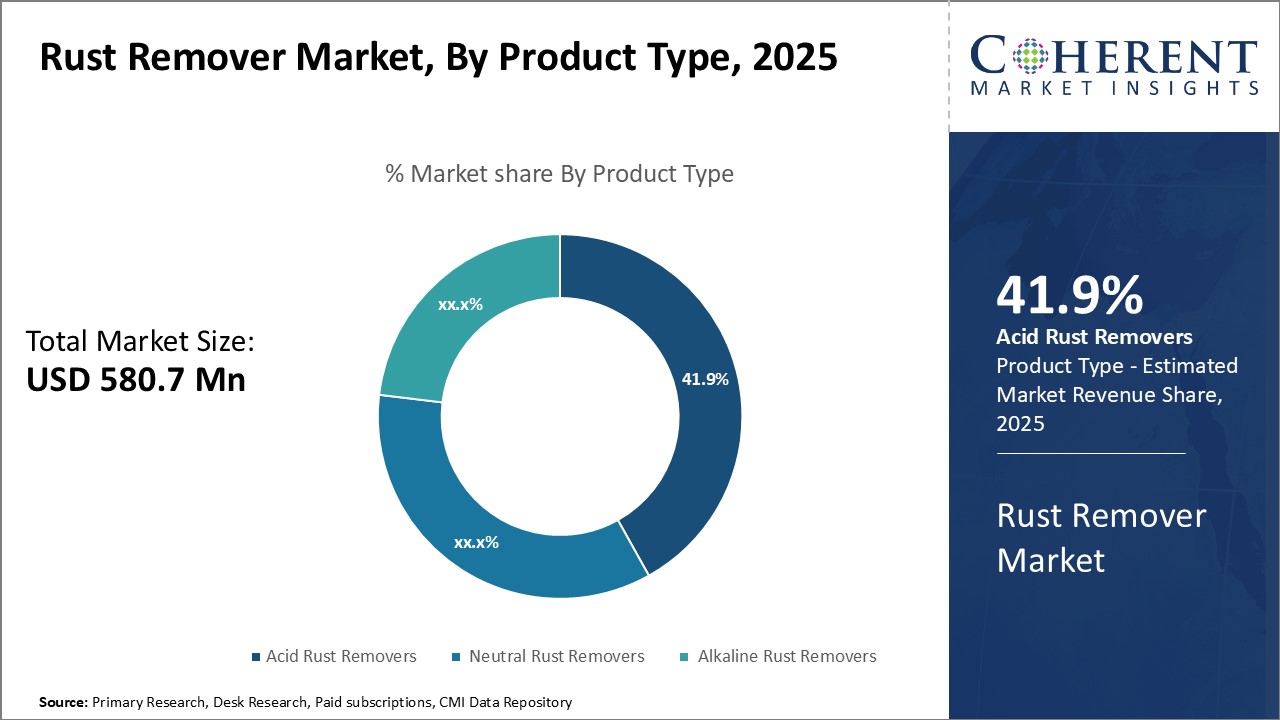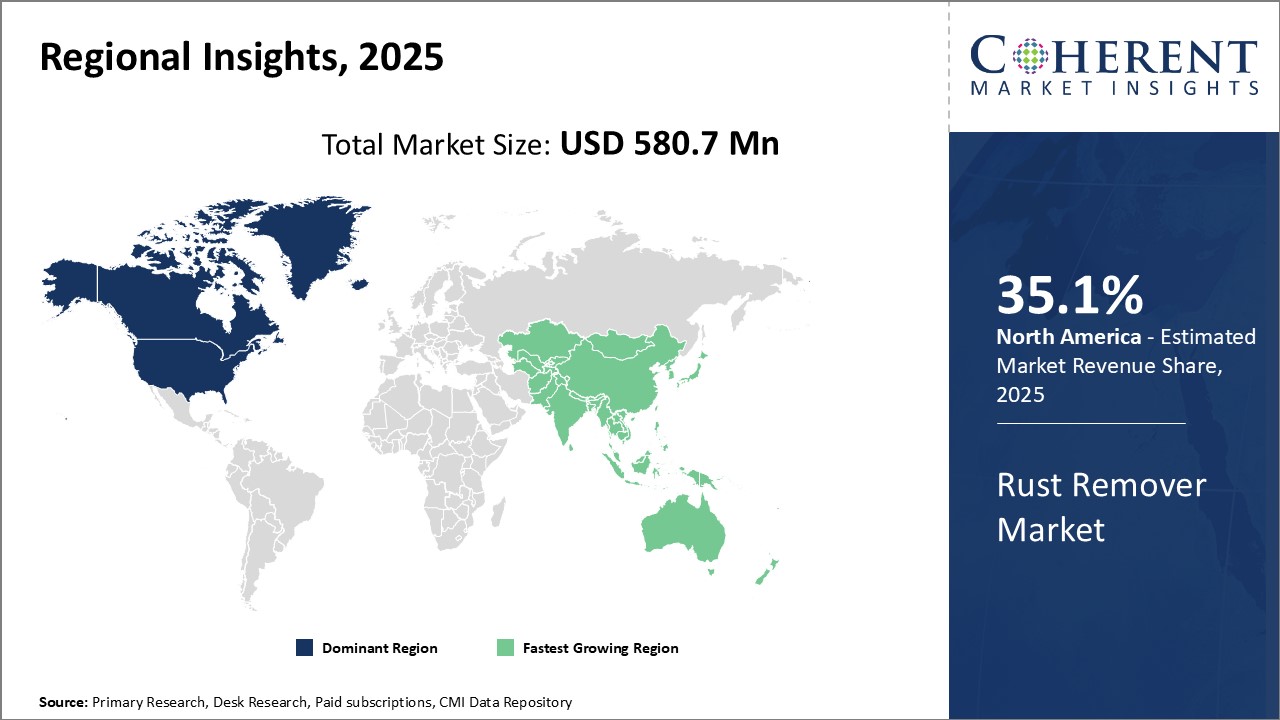Rust Remover Market Size and Trends
Global rust remover market is estimated to be valued at USD 580.7 Mn in 2025 and is expected to reach USD 856.5 Mn by 2032, exhibiting a compound annual growth rate (CAGR) of 5.7% from 2025 to 2032.

Discover market dynamics shaping the industry: Download Free Sample
Rising industrial activities is expected to drive the global rust remover market growth. Manufacturing and automotive industries rely on metal components that requires regular maintenance and cleaning. Growing industrialization and urbanization boosts demand for effective rust removing agents. Moreover, expansion of automotive and machinery production facilities worldwide can boost consumption of rust removers in the near future. However, availability of substitutes and stringent regulations regarding use of hazardous chemicals can hamper the market growth.
Rust's Destructive Nature
Rust occurs when iron or steel is exposed to oxygen and moisture over a period of time. This natural oxidation process can damage the metal surfaces it accumulates on. Rust only spreads and worsens with continued exposure to its catalyst elements. Eventually it can lead to severe corrosion that compromises the integrity of the material. Metal structures like vehicles, equipment, architectural features all rely on their strength and durability to serve their intended functions. But the insidiousness of rust poses a gradual threat to this as it silently eats away at the substrates. Once rust has taken hold, it is not so easy to eliminate. Its removal requires abrasive techniques and chemical treatments to strip layers of deposited iron oxide off the base material. Neglecting its presence assumes risks of corroded breakdown that may require replacement of heavily damaged parts. As industrialization has increased humanity's extensive use of iron alloys, there has been increase in need to arm against their degradation by rust. Its removal has become imperative for preserving capital investments in machinery, facilities and infrastructure with steel components. The costs of repair or reconstruction always far outweigh prevention in the form of regular rust removal processes. Maintaining the designed life cycle and performance levels of metallic assets demands ongoing abatement of rust accumulation before it advances to problematic severity.
Market Concentration and Competitive Landscape

Get actionable strategies to beat competition: Download Free Sample
Growing Industrial ApplicationsIndustrialization expanded the global market for rust removal products as machinery usage grew across manufacturing sectors. Core industries like automotive, shipbuilding naval, construction, mining equipment all incorporate large amounts of steel and iron into their capital goods manufacturing. And with mass production has come the parallel requirement to service fleets of revenue generating commercial assets with protective maintenance measures. The intensifying scale of industrial operations worldwide has boosted demand for chemical and mechanical solutions that arrest rust activity on factory systems, production lines and heavy metal capital assets. Efficient rust removal is essential for minimizing downtime on the industrial shop floors, shipyards, building sites and facilities where productivity depends on continuous availability of functioning machinery. Unaddressed rust can lead to repairs, performance issues or complete replacement that disrupt work processes. As emerging economies industrialize rapidly to develop their infrastructures and manufacturing capabilities, their adoption of advanced machinery also brings higher needs for rust elimination technologies. The competition to maximize utilization of installed industrial capacity puts a premium on maintenance procedures like rust removal that preserve equipment operational life and uptime.
Key Takeaways from Analyst:
Global rust remover market growth is driven by increasing industrialization and infrastructure development activities across developing regions of the world. The chemical and construction industries in contribute significantly to rust remover market growth.
Stringent regulations regarding the use of hazardous chemicals present in many conventional rust removal products can hamper the market growth. Many countries have banned the use of toxic chemicals like dichloromethane and methanol which are commonly used as solvents in rust removers. This will compel manufacturers to introduce eco-friendly alternatives.
Chemical-based rust removers have the largest share currently but powder/paste types are expected to witness higher growth rates owing to their easy usage and nil-toxicity features. Leading players are targeting the do-it-yourself (DIY) consumer segment by launching handy packaging sizes and gel/cream formulations for household applications.
Market Challenge: Availability of alternative rust removal methods
The availability of effective alternative rust removal methods is posing a challenge for the growth of the global rust remover market. Consumers now have access to eco-friendly and cost-effective DIY rust removal solutions which do not require the use of commercial rust remover products. For example, simple abrasives like steel wool or fine-grit sandpaper can be used to rub off surface rust when combined with WD-40 or vegetable oil. Baking soda is also emerging as a popular kitchen shelf product that can naturally remove rust stains when combined with vinegar or lemon juice in a paste-like form. Such simple methods reduce waste and are particularly appealing in the current environmentally-conscious marketplace.
Market Opportunity: Development of bio-based and environment-friendly rust removers
The development and adoption of bio-based and environment-friendly rust removers could present a major opportunity for companies in the global rust remover market. With growing environmental consciousness among consumers as well as regulations, there is increasing demand for sustainable and eco-friendly products. Rust removers that are plant-derived or contain natural ingredients with minimal toxic chemicals could appeal greatly to these consumers. More and more companies are investing in research and development of rust removal technologies that do not involve harsh acids or cause pollution. For example, some startups are developing methods using citric acid or potato extracts to break down rust. These remove rust efficiently while being less hazardous than traditional chemical-based solutions. With sustainable chemistry advancing, we may see innovative bioengineered or nanotechnology solutions that can tackle rust in an environmentally-friendly manner. Supportive government policies and subsidies in nations could also encourage their uptake.

Discover high revenue pocket segments and roadmap to it: Download Free Sample
Insights, By Product Type: Versatility and Cost-Effectiveness Boosts Demand for Acid Rust RemoversAmong product type segment of the global rust remover market, acid rust removers’ sub-segment is estimated to contribute the 41.9% share of the market in 2025, due to their versatility and cost-effectiveness compared to other product types. Acid rust removers are acidic formulations that contain phosphoric acid, hydrochloric acid, or citric acid as the active ingredient. The acid works by chemically reacting with rust particles to dissolve them from surfaces. This chemical reaction allows acid rust removers to tackle even heavily encrusted rust stains where sanding or mechanical methods would be ineffective or damage the underlying material. The acid formulation provides these products an advantage over neutral and alkaline removers in terms of penetration power. These can dissolve layered rust deposits from nooks and crannies that other products may struggle to reach. This makes acid removers suitable for a wide range of rust removal jobs across industries. Automotive repairs, ship maintenance, and construction renovation projects commonly use acid rust removers for their ability to cut through thick rust down to bare metal. Their strong penetrating properties also shorten removal time, allowing for efficient bulk rust stripping. The chemical erosion process requires less labor than wire brushing or grinding methods. Acid removers’ good value proposition partially explains their popularity as a maintenance and repair product. Low cost per use has cemented acid rust removers’ leading position in the product type segment.
Insights, By End User: Construction & Infrastructure Projects Spur Demand in End User Segment
Among end user segment of the global rust remover market, construction & infrastructure segment is estimated to contribute 36.3% share of the market in 2025 as increasing urbanization and industrialization drives massive investment into building construction as well as upgrading of existing infrastructure in developing regions. Megaprojects focused on roads, bridges, dams and other facilities require extensive usage of steel and iron materials that are prone to corrosion degradation over time in harsh outdoor environments. Stringent safety standards necessitate thorough rust removal and corrosion prevention on load-bearing steel during construction and renovations. Rust damage weakens steel strength and integrity, posing risks if not remediated properly. Therefore, large quantities of specialized rust removal chemicals are needed for preparatory surface treatment on metal components in construction. Demolition of older structures also generates byproduct scrap metal that often needs rust stripping before recycling or disposal. With increasing investments channeled into expanding cities and their ground transport/utility networks, constant demand arises for rust removers from various actors in the construction supply chain. The infrastructure segment encompasses routine maintenance of long-standing public works exposed to environmental corrosion. Bridges, pipelines, support towers and other installations require periodic rustproofing to extend their functional lifespans. This creates a recurring customer base reliant on rust removal products. The construction and infrastructure end user segment remains the main revenue driver due to its integral involvement across new building projects and upkeep of existing civic structures vital to economic development worldwide.
Regional Insights

Need a Different Region or Segment? Download Free Sample
North America has dominated the global rust remover market for several years with estimated 35.1% share in 2025, owing to the large automotive aftermarket and presence of key industry players in the region. The U.S. accounts for the largest share primarily due to the huge vehicle parc and growing do-it-yourself (DIY) culture. Consumers in the U.S. prefer affordable rust removal solutions to maintain their vintage and classic cars, recreational vehicles, machinery and equipment. This has boosted demand for rust removers over the years. The availability of a wide range of effective yet reasonably priced rust removing products from major brands has further aided the region's leadership position.
Asia Pacific has emerged as the fastest growing regional market for rust removers in recent times due to rapid industrialization and increasing consumption in developing countries. China is expected to witness uptake in the coming years buoyed by the expanding automotive refinishing industry and rising per capita spending on vehicle repair and maintenance. The focus on manufacturing sector development under national initiatives such as 'Make in India' has boosted the usage of industrial-grade rust removers across India. Furthermore, governments in Asia Pacific are undertaking various road and infrastructure projects, and this boosts demand for construction equipment where rust removal solutions find application.
Market Report Scope
Rust Remover Market Report Coverage
| Report Coverage | Details | ||
|---|---|---|---|
| Base Year: | 2024 | Market Size in 2025: | USD 580.7 Mn |
| Historical Data for: | 2020 To 2024 | Forecast Period: | 2025 To 2032 |
| Forecast Period 2025 to 2032 CAGR: | 5.7% | 2032 Value Projection: | USD 856.5 Mn |
| Geographies covered: |
|
||
| Segments covered: |
|
||
| Companies covered: |
Reckitt Benckiser Group, Jelmar LLC, The 3M Company, The Sherwin-Williams Company, Corrosion Technologies, LLC, Chempace Corporation, Fuchs Petrolub SE, Henkel Adhesives, Quaker Chemical Corporation, PPG Industries, Inc, Brunswick Corporation, RXSOL, Twin Tech India Pvt. Ltd., Lubrall Industries Private Limited., VINSA CHEMICALS PVT. LTD, Aerosol Group, Armor Protective Packaging, Rustonil, Vihan Techno Solutions, Chem Coat India |
||
| Growth Drivers: |
|
||
| Restraints & Challenges: |
|
||
Uncover macros and micros vetted on 75+ parameters: Get instant access to report
Rust Remover Industry News
- In March 2024, ProXL launched a new water-based rust remover
- In February 2024, CRC Industries launched a new one-quart canister of its Evapo-Rust rust remover
- In March 2023, PPG Industries launched the PPG ENVIROCRON Primeron primer powder, aiming to protect and provide superior corrosion resistance to metal substrates like aluminum, metalized steel, and hot-dip galvanized steel
- In 2022, Cortec introduced ecoclean scale and rust remover
*Definition: Global Rust Remover Market offers a variety of rust removal solutions that help consumers and industries easily get rid of rust. Products in this market include chemical-based rust removers that use acids or other corrosion-inhibiting ingredients to break down rust at a molecular level. There are also abrasive rust removers that use grit or micro-abrasives to manually grind off rust.
Market Segmentation
- Product Type Insights (Revenue, USD Mn, 2020 - 2032)
- Acid Rust Removers
- Neutral Rust Removers
- Alkaline Rust Removers
- End User Insights (Revenue, USD Mn, 2020 - 2032)
- Aviation and Aerospace
- Automotive
- Oil and Gas
- Marine
- Construction & Infrastructure
- Metal Machining
- Others
- Regional Insights (Revenue, USD Mn, 2020 - 2032)
- North America
- U.S.
- Canada
- Latin America
- Brazil
- Argentina
- Mexico
- Rest of Latin America
- Europe
- Germany
- U.K.
- Spain
- France
- Italy
- Russia
- Rest of Europe
- Asia Pacific
- China
- India
- Japan
- Australia
- South Korea
- ASEAN
- Rest of Asia Pacific
- Middle East & Africa
- GCC Countries
- Israel
- Rest of Middle East & Africa
- North America
- Key Players Insights
- Reckitt Benckiser Group
- Jelmar LLC
- The 3M Company
- The Sherwin-Williams Company
- Corrosion Technologies, LLC
- Chempace Corporation
- Fuchs Petrolub SE
- Henkel Adhesives
- Quaker Chemical Corporation
- PPG Industries, Inc
- Brunswick Corporation
- RXSOL
- Twin Tech India Pvt. Ltd.
- Lubrall Industries Private Limited.
- VINSA CHEMICALS PVT. LTD
- Aerosol Group
- Armor Protective Packaging
- Rustonil
- Vihan Techno Solutions
- Chem Coat India
Share
Share
About Author
Vidyesh Swar is a seasoned Consultant with a diverse background in market research and business consulting. With over 6 years of experience, Vidyesh has established a strong reputation for his proficiency in market estimations, supplier landscape analysis, and market share assessments for tailored research solution. Using his deep industry knowledge and analytical skills, he provides valuable insights and strategic recommendations, enabling clients to make informed decisions and navigate complex business landscapes.
Missing comfort of reading report in your local language? Find your preferred language :
Transform your Strategy with Exclusive Trending Reports :
Frequently Asked Questions
EXISTING CLIENTELE
Joining thousands of companies around the world committed to making the Excellent Business Solutions.
View All Our Clients
